Your browser does not fully support modern features. Please upgrade for a smoother experience.
Please note this is an old version of this entry, which may differ significantly from the current revision.
Maximum Power Point Tracking (MPPT), or sometimes just Power Point Tracking (PPT), is a technique used with variable power supplies to maximize energy extraction as conditions change.
- impedance matching
- maximum power point tracking (MPPT)
- DC-DC converter
- solar PV (SPV) systems
1. Introduction
In the following decade, energy demand has surged enormously worldwide. This resulted in an arduous challenge of gush in energy demand as a result of overall socio-economic growth [1]. Prominent among prevailing renewables, the photovoltaic cell (solar PV) is on the leading edge [2], but the efficiency of the solar PV structure is not adequate so as to boost the efficiency; it must be driven at a point where it can extort the utmost potential power from it. Current literature reveals that research exertions are being made to boost the output of modules in the context of MPPT. The characteristics of an SPV module are non-linear and its power vs. voltage characteristics indicate that there subsists a solitary point (Pm) at which the module delivers maximum power [3]. The point Pm deviates due to change in temperature and/or insolation [4][5]. Consequently, the mismatch between the source and load characteristics lessens the availability of the utmost potential accessible power transmitted to the load, leading to huge power losses. To minimize power loss, the MPPT algorithm ensures that the impedance of the source will be equal to or near to the load impedance which is done by the DC-DC converter. Classification and comparison of MPPT techniques are also available in the literature [6][7][8]. MPPT techniques in solar photovoltaic systems under uniform insolation [9][10][11] and partially shaded conditions [12][13][14] are also compared in the literature.
2. Operating Strategy of MPPT
The functioning of MPPT has explicated an example for tracking maximum power through the changes in insolation, as depicted in Figure 1a. Figure 1b depicts characteristics of a solar cell for a linear resistive-type load (RL = 10 Ω); it has three maximum power points (MPPs) which are A′, B′, and C′ on three different insolation level. Since the load is linear, the operating points of the cell and the respective terminal voltages are A, B, and C. It is apparent from Figure 1a,b that the power delivered via the solar cell concerning A, B, and C is less than the power available [15].
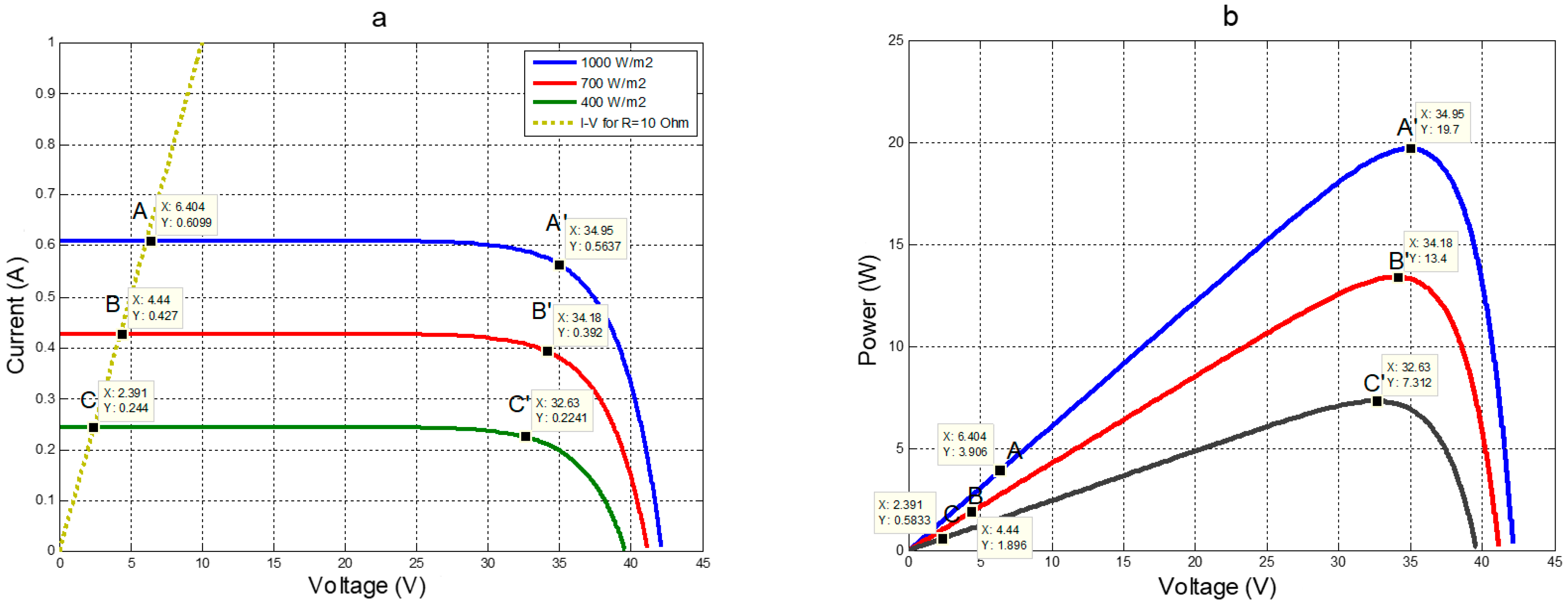
Figure 1. MPP for different insolation on (a) current vs. voltage curve and (b) power vs. voltage curve.
The MPPT functioning evokes the concept of seizing the terminal voltage corresponding to the MPPs which are A′, B′, and C′ in place of the operating points A, B, and C. To heave the operating point of the solar cell at the MPP, an electronic circuitry recognized as the DC-DC converter was utilized in MPPT [16][17][18].
3. Impedance Matching by DC-DC Converter in MPPT Operation
In the tracking of MPP, the DC-DC converter is a vital component as the source is capable of delivering the utmost power only corresponding to VMPP or IMPP. Although, in designing a DC-DC converter, it is quite problematic to move the terminal voltage (Vi) or current (Ii) of an SPV module in consequence to a VMPP or IMPP. Here demonstrates the MPPT algorithms based on various designs of the DC-DC converter [15] in which the impedance as perceived from a solar PV (Zsource) matches the analogous impedance at the MPP (Zmpp = Vmpp/Impp). Figure 2 depicts the block illustration of the general MPPT operation. A comparison of MPPT algorithms and the control of DC-DC converters is presented in [19][20][21][22].
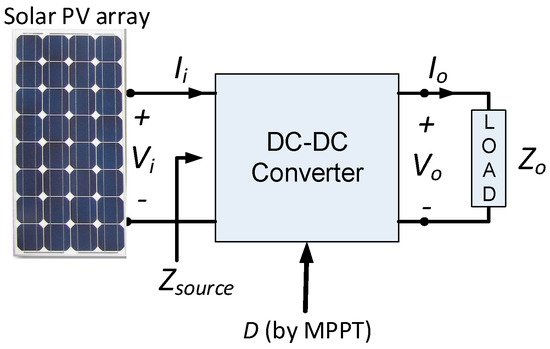
Figure 2. Block illustration of general MPPT operation.
To authenticate the response of the converters, simulations are accomplished in MATLAB’s SIMSCAPE library, which is closer to the practical design. The N-channel MOSFET is utilized for the switching function and it is directed through a voltage-controlled PWM generator. The general operation of MPPT is depicted in Figure 2, wherein the input constraints are sensed and processed by the MPPT controller, thus the duty cycle is set accordingly by the MPPT algorithm. The DC-DC converter works at this duty cycle to deliver the utmost power to the load. More than 31 MPPT techniques have been found in the literature and of these 31 techniques, the perturbation and observation (P&O) or hill climbing is well-liked, with the benefits of ease of realization and involving less complex circuitry.
4. P&O/Hill Climbing Technique of MPPT
The P&O technique is one of the well-liked MPPT techniques. The technique is fundamentally an iterative approach. In this technique, the operating point of the SPV module swings around the MPP. The power vs. voltage curve of a solar PV shows that the change in power in regards to voltage (dP/dV) is positive, negative, and zero for the province before the MPP, after the MPP, and at the MPP, respectively [23][24].
This technique is realized by perturbing the duty ratio at regular intervals and swinging around the point dP/dV = 0, i.e., MPP. This operation is explicated in Figure 3 and the methodology is given in Table 1.
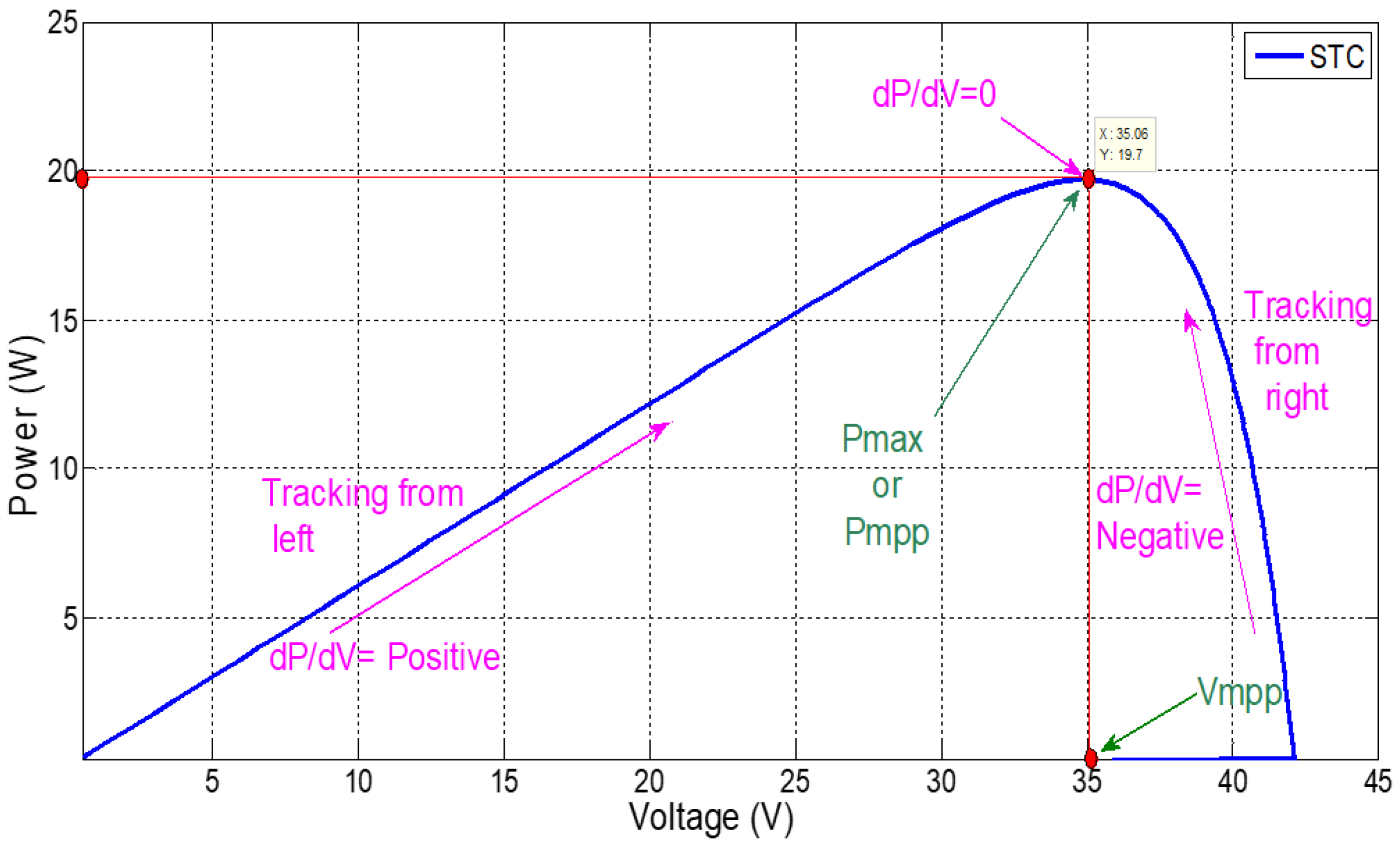
Figure 3. Power characteristic of SPV in perspective with P&O MPPT.
Table 1. Methodology of P&O technique [23].
| Perturbation | Change in Power | Next Perturbation |
|---|---|---|
| (+) Positive | (+) Positive | (+) Increment in duty ratio ‘D’ |
| (+) Positive | (−) Negative | (−) Decrease in duty ratio ‘D’ |
| (−) Negative | (+) Positive | (−) Decrease in duty ratio ‘D’ |
| (−) Negative | (−) Negative | (+) Increment in duty ratio ‘D’ |
5. Proposed MPPT Technique
The proposed MPPT technique is based on a modified converter design [15] as the DC-DC converters are playing a very important role in MPPT. The design of DC-DC converters is an essential part of any MPPT scheme [25][26]. Application of conventional DC-DC buck converters [27][28], boost converters [29][30][31], buck-boost converters [32][33][34], novel converters [35][36], and multilevel inverters [37][38] are also reported in the literature for MPPT operation.
The behavior of DC-DC converters is observed for variation in the duty cycle for the buck, boost, and buck-boost converters in here and is explained in the subsequent section.
5.1. Boost Converter: Relation between Output Voltage, Output Current, Output Power, and VPV
A graph of the output voltage, output current, output power, and VPV with variation in the duty cycle is presented in Figure 4. It shows that the point of maximum power occurs when the load voltage is at the maximum.
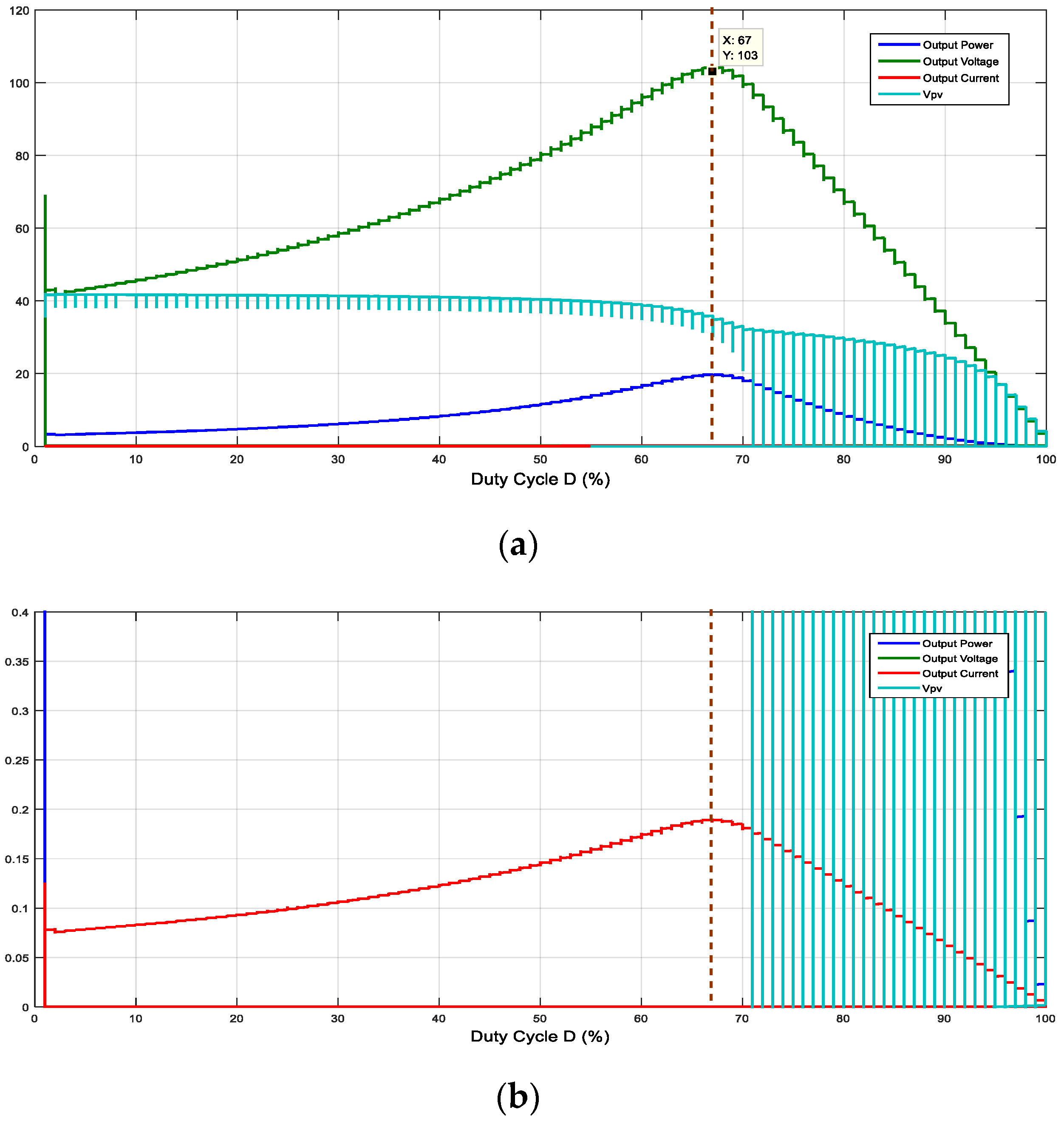
Figure 4. Boost converter: graph of output current, output power, and VPV with duty cycle.
The current is also at the maximum where the power is maximum ay D = 67%, which is not visible in Figure 4a; by zooming in at the Y-axis, it is clear in Figure 4b.
5.2. Buck Converter: Relation between Output Voltage, Output Current, Output Power, and VPV
A graph of the output voltage, output current, output power, and VPV with the duty cycle is presented in Figure 5.
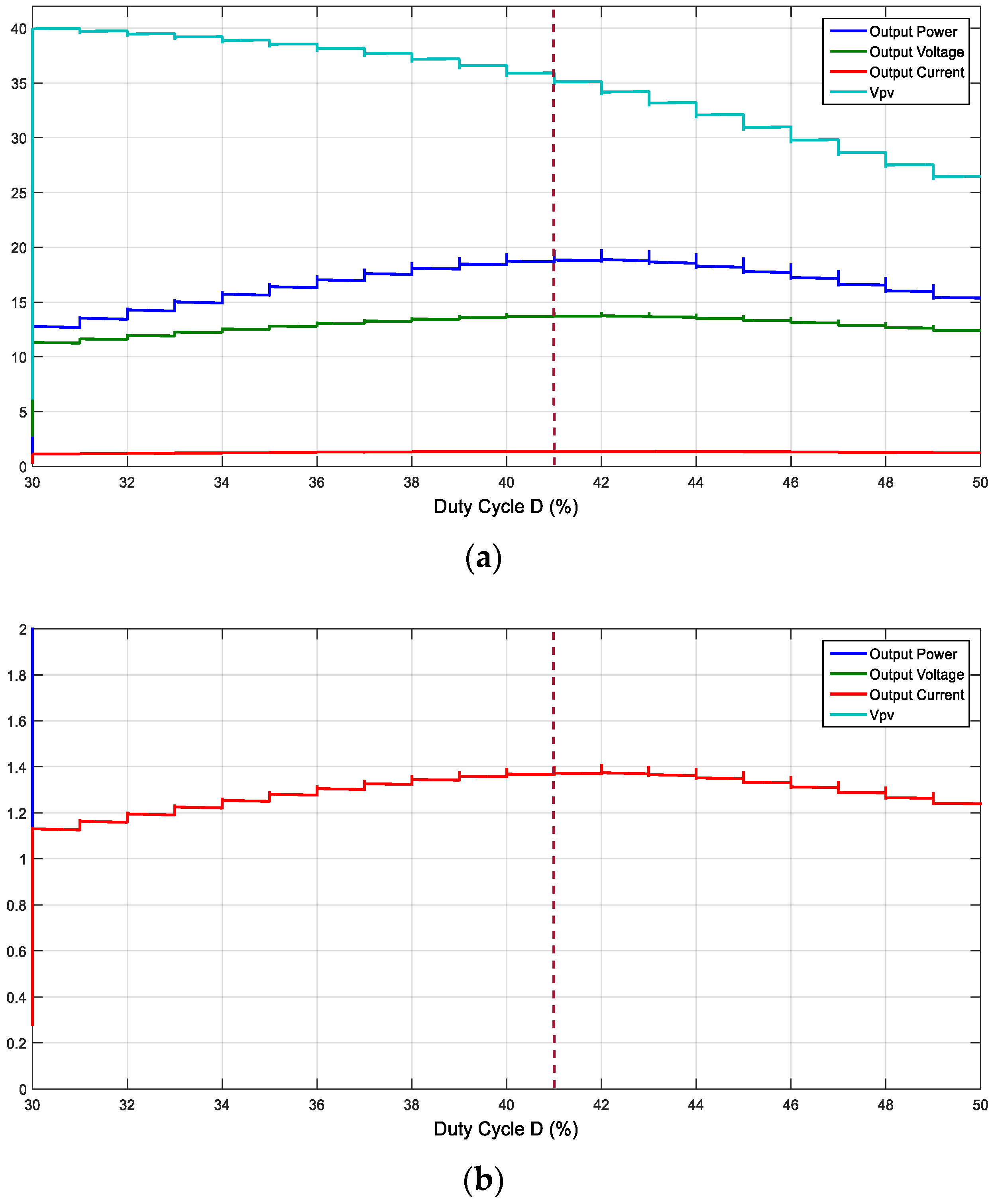
Figure 5. Buck converter: graph of output voltage, output current, output power, and VPV with duty cycle.
Figure 5 shows that the point of maximum power occurs when the load voltage is at the maximum at duty cycle D = 41% [15].
The current is also at the maximum where the power is maximum ay D = 41%, which is not visible in Figure 5a; by zooming in at the Y-axis, it is clear in Figure 5b.
5.3. Buck-Boost Converter: Graph of Output Voltage, Output Current, Output Power, and VPV with the Duty Cycle
A graph of the output voltage, output current, output power, and VPV with the duty cycle is presented in Figure 6. It shows that the point of maximum power occurs when the load voltage is at the maximum at duty cycle D = 75% [15]. The current is also at the maximum where the power is at the maximum at D = 75%, which is not visible in Figure 6a; by zooming in at the Y-axis, it is clear in Figure 6b.

Figure 6. Buck-boost converter: graph of output voltage, output current, output power, and VPV with duty cycle.
5.4. Operating Principle of Proposed MPPT Technique
The conventional P&O method senses input parameters or PV side parameters, i.e., VPV and IPV, and compares power at different time intervals as well as keeps on oscillating around the maximum power. The maximum power will be transferred to the load when the load side voltage will be at the maximum. An MPPT technique is proposed which maximizes the load voltage in contrast to VPV in conventional P&O and causes maximum power to be delivered to the load, as shown in Figure 7. The calculated duty cycle for standard environmental conditions gives the maximum power at which the load voltage is at the maximum; this duty cycle becomes the maximum duty cycle (Dmax). The minimum duty cycle (Dmin) will be calculated by assuming the minimum set of environmental conditions, such as, for example, an insolation of 50 W/m2 and temperature of 25 °C. Calculation of Dmin and Dmax depends on the location of the solar PV array. In the proposed MPPT technique, the perturbation of the duty cycle is done within the range of Dmin to Dmax to maximize the load voltage; in this way, the proposed method becomes the PV array-dependent method. Nevertheless, the response time to achieve MPP becomes less.
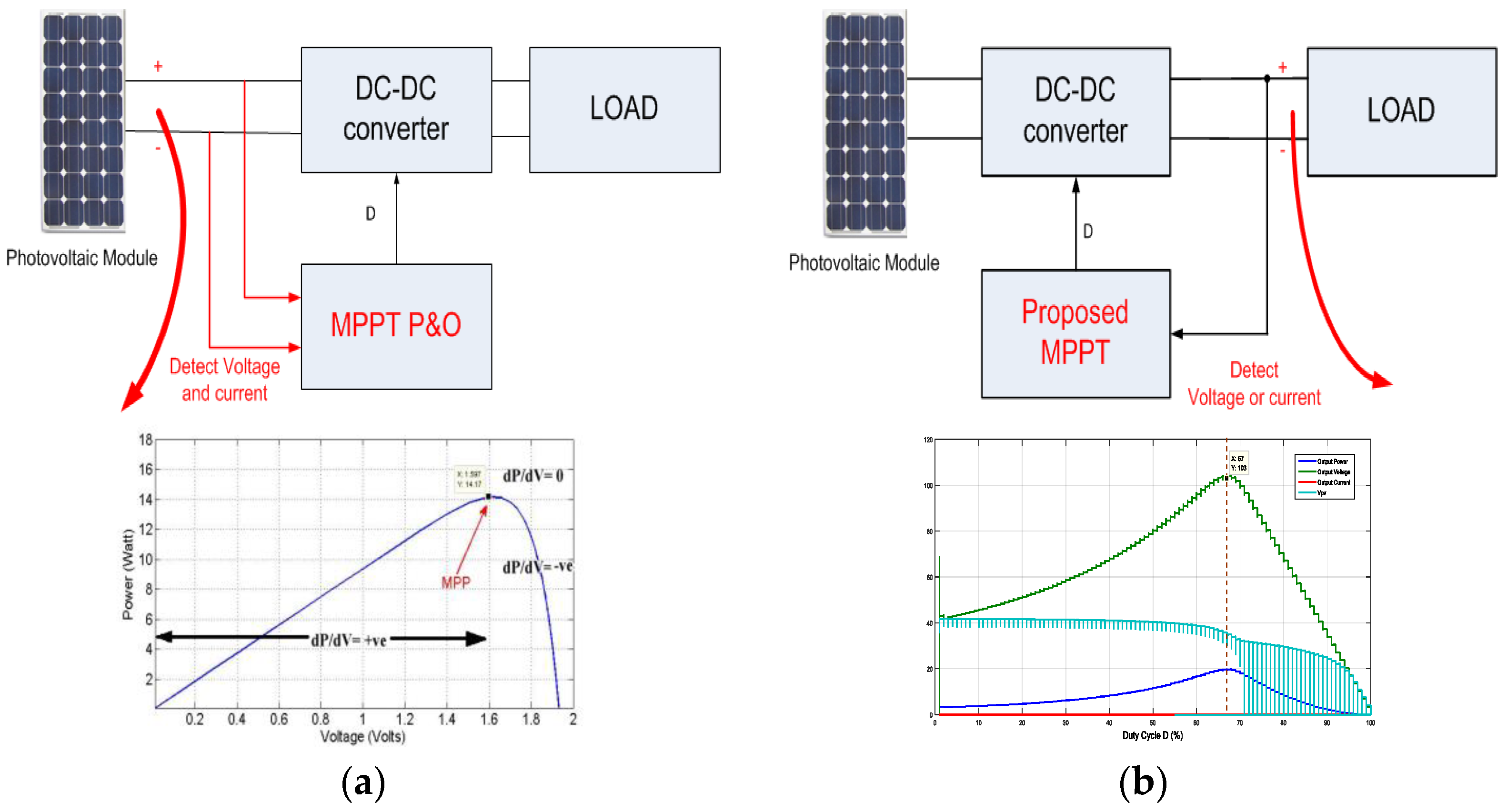
Figure 7. Comparison of (a) conventional P&O method with (b) proposed method in terms of sensing parameters.
This novel method is applied by perturbing the duty ratio at regular intervals and observing the load voltage, thus oscillating around the point, i.e., MPP. The operation is explained in Figure 7 and Table 2.
Table 2. Methodology of the proposed method.
| Perturbation | Change in Load Voltage | Next Perturbation |
|---|---|---|
| (+) Positive | (+) Positive | (+) Increment in duty ratio ‘D’ |
| (+) Positive | (−) Negative | (−) Decrease in duty ratio ‘D’ |
| (−) Negative | (+) Positive | (−) Decrease in duty ratio ‘D’ |
| (−) Negative | (−) Negative | (+) Increment in duty ratio ‘D’ |
5.5. Flow Chart of Proposed MPPT Algorithm
Figure 8 shows the flow chart of the proposed MPPT method. The method applies the perturbation in the duty cycle within a predetermined range (Dmin to Dmax) to regulate the output voltage of the converter or the load side voltage. The initial conditions are assumed to be zero, which means the previous value of the voltage and duty cycle is zero. The algorithm starts with the minimum value of the duty cycle (Dmin); senses the load voltage, which is is Vnew; and compares it to the previous value of the load voltage (Vold) if Vnew > Vold and Dnew > Dold. Then, the next perturbation is the positive increment of the duty cycle. The MPPT operation follows the methodology presented in Table 2.
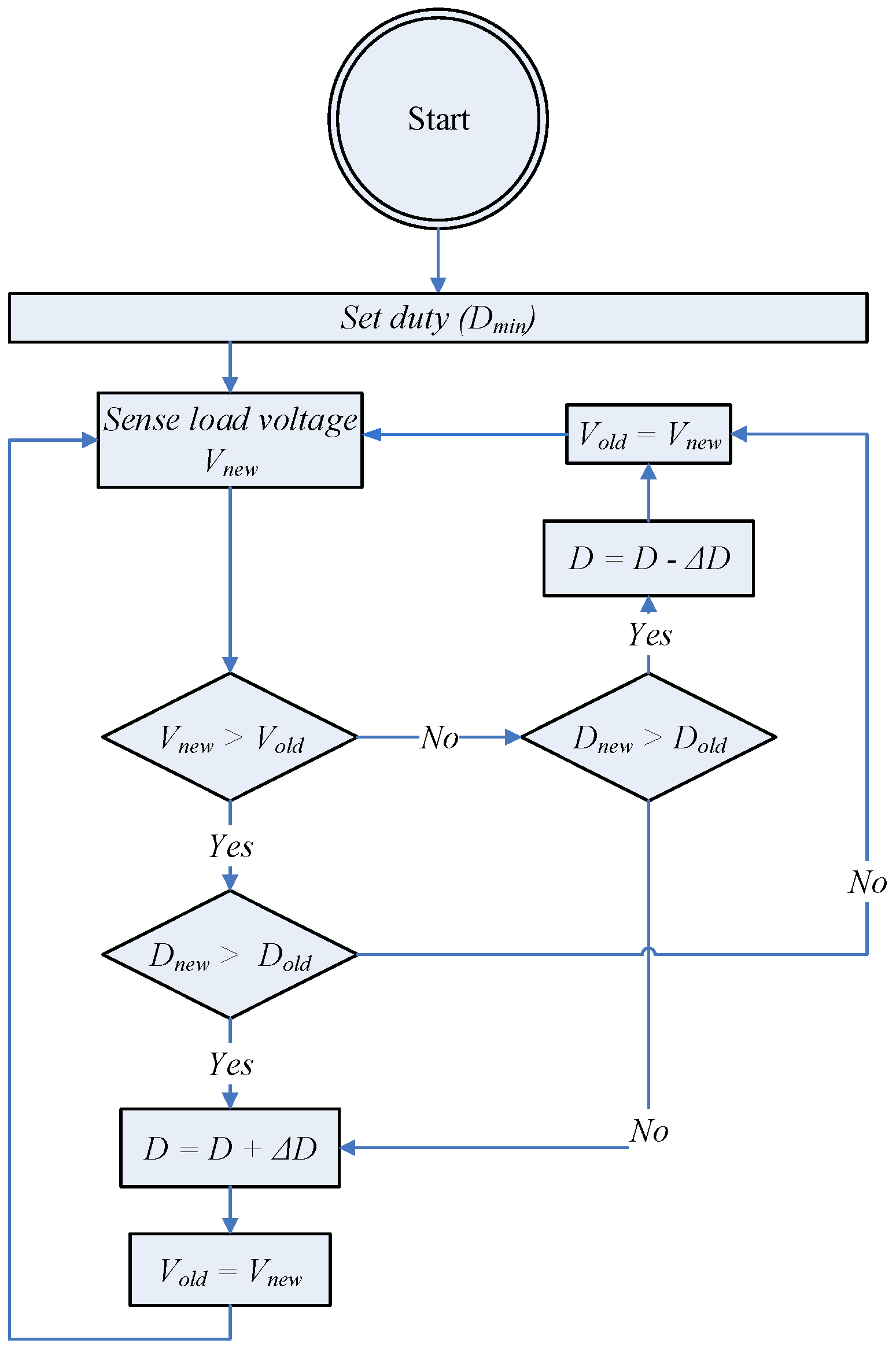
Figure 8. Flow chart of proposed MPPT algorithm.
This entry is adapted from the peer-reviewed paper 10.3390/electronics11071053
References
- Chauhan, A.; Saini, R.P. A review on integrated renewable energy system based power generation for stand-alone applications: Configurations, storage options, sizing methodologies and control. Renew. Sustain. Energy Rev. 2014, 38, 99–120.
- Lesourd, J.-B. Solar photovoltaic systems: The economics of a renewable energy resource. Environ. Model. Softw. 2001, 16, 147–156.
- Maamar, S.; Salha, O.B. On the causal dynamics between economic growth, renewable energy consumption, CO2 emissions and trade openness, Fresh evidence from BRICS countries. Renew. Sustain. Energy Rev. 2014, 39, 14–23.
- Mohamed, A.E.; Zhao, Z. MPPT techniques for photovoltaic applications. Renew. Sustain. Energy Rev. 2013, 25, 793–813.
- Libra, M.; Petrík, T.; Poulek, V.; Tyukhov, I.I.; Kouřím, P. Changes in the Efficiency of Photovoltaic Energy Conversion in Temperature Range with Extreme Limits. IEEE J. Photovolt. 2021, 11, 1479–1484.
- Kashif, I.; Salam, Z. A review of maximum power point tracking techniques of PV system for uniform insolation and partial shading condition. Renew. Sustain. Energy Rev. 2013, 19, 475–488.
- Bidyadhar, S.; Pradhan, R. A comparative study on maximum power point tracking techniques for photovoltaic power systems. IEEE Trans. Sustain. Energy 2013, 4, 89–98.
- Reisi, R.; Hassan Moradi, M.A.; Jamasb, S. Classification and comparison of maximum power point tracking techniques for photovoltaic system, A review. Renew. Sustain. Energy Rev. 2013, 19, 433–443.
- Verma, D.; Nema, S.; Shandilya, A.M.; Dash, S.K. Maximum power point tracking (MPPT) techniques: Recapitulation in solar photovoltaic systems. Renew. Sust. Energy Rev. 2016, 54, 1018–1034.
- Dash, S.K.; Verma, D.; Nema, S.; Nema, R.K. Comparative analysis of maximum power point (MPP) tracking techniques for solar PV application using MATLAB Simulink. In Proceedings of the International Conference on Recent Advances and Innovations in Engineering, Jaipur, India, 9–11 May 2014; pp. 1–7.
- Soubhagya, D.K.; Verma, D.; Nema, S.; Nema, R.K. Shading mitigation techniques: State-of-the-art in photovoltaic applications. Renew. Sustain. Energy Rev. 2017, 78, 369–390.
- Kumar Dash, S.; Nema, S.; Nema, R.K.; Verma, D. A comprehensive assessment of maximum power point tracking techniques under uniform and non-uniform irradiance and its impact on photovoltaic systems: A review. J. Renew. Sustain. Energy 2015, 7, 063113.
- Verma, D.; Nema, S.; Shandilya, A.M.; Dash, S.K. Comprehensive analysis of maximum power point tracking techniques in solar photovoltaic systems under uniform insolation and partial shaded condition. J. Renew. Sustain. Energy 2015, 7, 042701.
- Rajput, P.; Malvoni, M.; Manoj Kumar, N.; Sastry, O.S.; Jayakumar, A. Operational Performance and Degradation Influenced Life Cycle Environmental–Economic Metrics of mc-Si, a-Si and HIT Photovoltaic Arrays in Hot Semi-arid Climates. Sustainability 2020, 12, 1075.
- Verma, D.; Nema, S.; Shandilya, A.M. A Different Approach to Design Non-Isolated DC–DC Converters for Maximum Power Point Tracking in Solar Photovoltaic Systems. J. Circuits Syst. Comput. 2016, 25, 1630004.
- Nebti, K.; Lebied, R. Fuzzy Maximum Power Point Tracking Compared to Sliding Mode Technique for Photovoltaic Systems Based on DC-DC Boost Converter (2021). Electr. Eng. Electromech. 2021, 1, 67–73.
- Situmorang, M.; Peranginangin, B. Performance assessment of photovoltaic generator(pvg) power system using maximum power point tracking (mppt) dc to dc boost converter and dc to ac inverter. J. Phys. Conf. Ser. 2020, 1485, 012061.
- Zainuri, M.A.A.M.; Azari, E.A.; Ibrahim, A.A.; Ayob, A.; Yusof, Y.; Radzi, M.A.M. Analysis of adaptive perturb and observe-fuzzy logic control maximum power point tracking for photovoltaic boost DC-DC converter. Int. J. Adv. Trends Comput. Sci. Eng. 2019, 8, 201–210.
- Shadlu, M.S. Comparison of maximum power point tracking (MPPT) algorithms to control DC-DC converters in photovoltaic systems. Recent Adv. Electr. Electron. Eng. 2019, 12, 355–367.
- Zainuri, M.A.A.M.; Radzi, M.A.M.; Rahman, N.F.A. Photovoltaic boost DC/DC converter for power led with adaptive p&o-fuzzy maximum power point tracking. Lect. Notes Electr. Eng. 2019, 547, 245–251.
- Surya, P.P.; Irawan, D.; Zuhri, M. Review and comparison of DC-DC converters for maximum power point tracking system in standalone photovoltaic (PV) module. In Proceedings of the ICAMIMIA 2017: International Conference on Advanced Mechatronics, Intelligent Manufacture, and Industrial Automation, Surabaya, Indonesia, 12–14 October 2017; pp. 242–247.
- Sultan, N.S. Design and comparative study of photovoltaic maximum power point tracking converter with DC motor speed control. In Proceedings of the 1st International Scientific Conference of Engineering Sciences—3rd Scientific Conference of Engineering Science; ISCES 2018—Proceedings, Diyala, Iraq, 10–11 January 2018; pp. 74–79.
- Verma, D.; Nema, S.; Nema, R.K. Implementation of Perturb and Observe Method of Maximum Power Point Tracking in SIMSCAPE/MATLAB. In Proceedings of the IEEE International Conference on Intelligent Sustainable Systems, Palladam, Tamil Nadu, India, 7–8 December 2017.
- Amarnath, R.K.; Deepak Verma, N. Harmonics Mitigation of P&O MPPT Based Solar Powered Five-Level Diode-Clamped Multilevel Inverter. In Proceedings of the IEEE International Conference on Innovations in Control, Communication and Information System, Greater Noida, India, 12–13 August 2017.
- Hart, D.W. Power Electronics; Tata McGraw-Hill Education: Noida, India, 2011.
- Paul, S.; Jacob, K.P.; Jacob, J. Solar photovoltaic system with high gain dc to dc converter and maximum power point tracking controller. J. Green Eng. 2020, 10, 2956–2972.
- Hauke, B. Basic Calculation of a Buck Converter’s Power Stage; Technical Report, SLVA477; Texas Instruments: Dallas, TX, USA, 2014.
- Altamimi, A.; Khan, Z.A. A DC-DC buck converter with maximum power point tracking implementation for photovoltaic module application. In Proceedings of the 2017 IEEE Conference on Energy Conversion, CENCON 2017, Kuala Lumpur, Malaysia, 30–31 October 2017; pp. 305–310.
- Hauke, B. Basic Calculation of a Boost Converter’s Power Stage; Application Report; Texas Instruments: Dallas, TX, USA, 2012.
- Bulut, K.; Ghaderi, D. Maximum power point tracking by the small-signal-based pi and fuzzy logic controller approaches for a two-stage switched-capacitor dc-dc power boost converter; applicable for photovoltaic utilizations. El-Cezeri J. Sci. Eng. 2020, 7, 1167–1190.
- Shaw, P.; Garanayak, P. Analysis, design and implementation of analog circuitry-based maximum power point tracking for photovoltaic boost DC/DC converter. Trans. Inst. Meas. Control 2019, 41, 668–686.
- Sahu, P.; Deepak, V.; Savita, N. Physical design and modelling of boost converter for maximum power point tracking in solar PV systems. In Proceedings of the IEEE International Conference on Electrical Power and Energy Systems (ICEPES), Bhopal, India, 14–16 December 2016.
- Maiti, A.; Mukherjee, K.; Syam, P. Design, modeling and software implementation of a current-perturbed maximum power point tracking control in a DC-DC boost converter for grid-connected solar photovoltaic applications. In Proceedings of the 2016 IEEE 1st International Conference on Control, Measurement and Instrumentation, CMI 2016, Kolkata, India, 8–10 January 2016; pp. 36–41.
- Green, M. Design Calculations for Buck-Boost Converters; Application Report; Texas Instruments: Dallas, TX, USA, 2012.
- Banumalar, K.; Lakshmi, R.T.; Manikandan, B.V.; Chandrasekaran, K. A Novel Modified DC/DC/AC Converter for Maximum Power Point Tracking from Photovoltaic System. In EAI/Springer Innovations in Communication and Computing; Springer: Berlin/Heidelberg, Germany, 2021; pp. 463–479.
- Shanthi, T. Incremental conductance method of maximum power point tracking for photovoltaic array with single switch DC/DC converter. J. Adv. Res. Dyn. Control. Syst. 2017, 9, 1181–1191.
- Mao, M.; Zhang, L.; Duan, Q.; Chong, B. Multilevel DC-link converter photovoltaic system with modified PSO based on maximum power point tracking. Sol. Energy 2017, 153, 329–342.
- Nikhil, K.; Gawre Suresh, K.; Deepak, V. Modeling and Simulation of Solar Photovoltaic System and Interfacing with Neutral Point clamped Multilevel Inverter. In Proceedings of the International Conference in Electrical, Electronics and Computer Science (ICEECS-2014), Chennai, India, 24–25 November 2017; Volume 30.
This entry is offline, you can click here to edit this entry!
